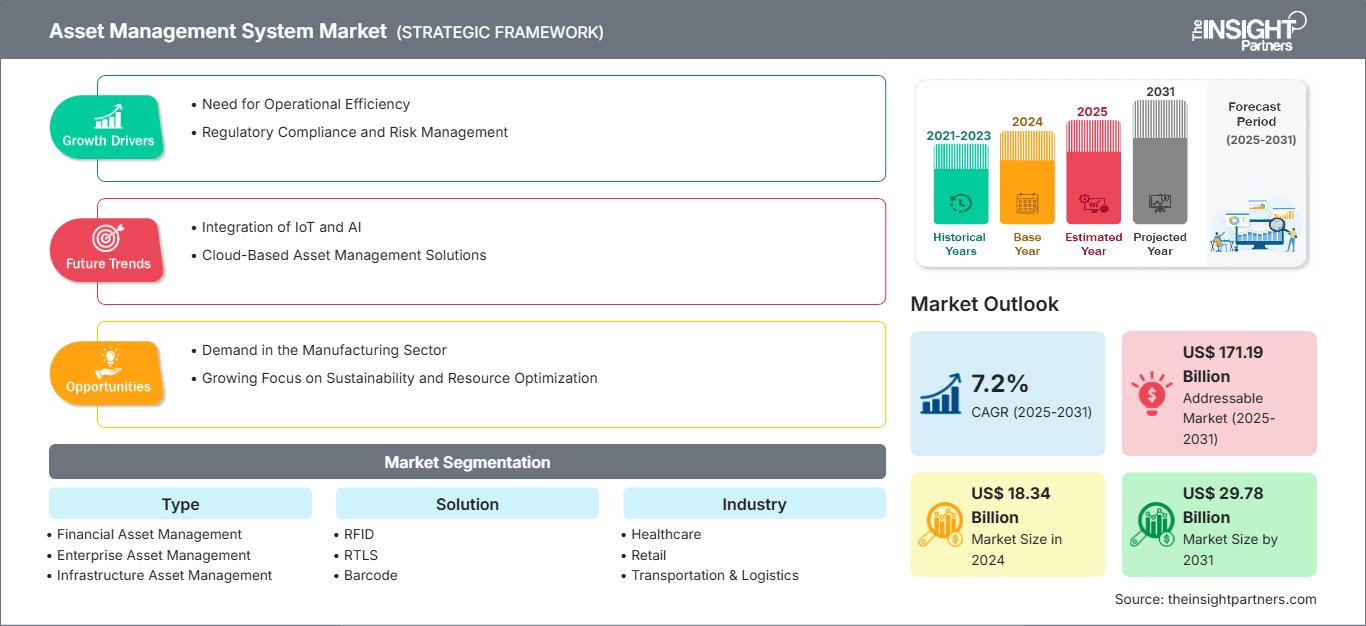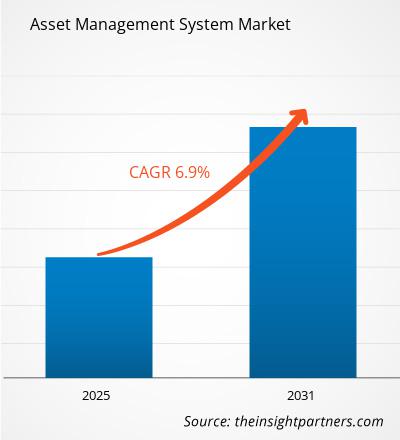Le marché des systèmes de gestion d'actifs devrait atteindre 29,78 milliards de dollars américains d'ici 2031, contre 18,34 milliards de dollars américains en 2024 ; il devrait enregistrer un TCAC de 7,2 % au cours de la période de prévision.
Le rapport est segmenté par type (gestion d'actifs financiers, gestion d'actifs d'entreprise, gestion d'actifs d'infrastructure, gestion d'actifs publics, gestion d'actifs informatiques, gestion d'actifs fixes et gestion d'actifs numériques) ; solution (RFID, RTLS, code-barres, GPS et autres) ; et secteur d'activité (santé, vente au détail, transport et logistique, pétrole et gaz, exploitation minière et autres). L'analyse mondiale est ensuite ventilée au niveau régional et par principaux pays. Le rapport offre la valeur en USD pour l'analyse et les segments ci-dessus.
Objectif du rapport
Le rapport sur le marché des systèmes de gestion d'actifs de The Insight Partners vise à décrire le paysage actuel et la croissance future, les principaux facteurs moteurs, les défis et les opportunités. Cela fournira des informations à diverses parties prenantes commerciales, telles que :
- Fournisseurs/fabricants de technologies : pour comprendre l’évolution de la dynamique du marché et connaître les opportunités de croissance potentielles, leur permettant de prendre des décisions stratégiques éclairées.
- Investisseurs : pour effectuer une analyse complète des tendances concernant le taux de croissance du marché, les projections financières du marché et les opportunités qui existent tout au long de la chaîne de valeur.
- Organismes de réglementation : pour réglementer les politiques et surveiller les activités du marché dans le but de minimiser les abus, de préserver la confiance des investisseurs et de maintenir l’intégrité et la stabilité du marché.
Type de segmentation du marché des systèmes de gestion d’actifs
- Gestion des actifs financiers
- Gestion des actifs d’entreprise
- Gestion des actifs d’infrastructure
- Gestion des actifs publics
- Gestion des actifs informatiques
- Gestion des immobilisations et gestion des actifs numériques
Solution
- RFID
- RTLS
- Code-barres
- GPS et autres
Industrie
- Santé
- Vente au détail
- Transport et logistique
- Pétrole et gaz
- Exploitation minière et autres
Géographie
- Amérique du Nord
- Europe
- Asie-Pacifique
- Amérique du Sud et centrale
- Moyen-Orient et Afrique
Vous bénéficierez d’une personnalisation sur n’importe quel rapport - gratuitement - y compris des parties de ce rapport, ou une analyse au niveau du pays, un pack de données Excel, ainsi que de profiter d’offres exceptionnelles et de réductions pour les start-ups et les universités
Marché des systèmes de gestion d'actifs: Perspectives stratégiques

-
Obtenez les principales tendances clés du marché de ce rapport.Cet échantillon GRATUIT comprendra une analyse de données, allant des tendances du marché aux estimations et prévisions.
Facteurs de croissance du marché des systèmes de gestion d'actifs
- Besoin d'efficacité opérationnelle : les entreprises de tous les secteurs se concentrent sur l'amélioration de l'efficacité opérationnelle pour réduire les coûts et maximiser la productivité. Les systèmes de gestion d'actifs jouent un rôle essentiel en offrant une visibilité en temps réel sur l'utilisation des actifs, les calendriers de maintenance et la gestion du cycle de vie. Cela aide les organisations à optimiser les performances de leurs actifs, à réduire les temps d'arrêt et à améliorer l'allocation des ressources, stimulant ainsi la croissance du marché.
- Conformité réglementaire et gestion des risques : des réglementations de plus en plus strictes et le besoin de gestion des risques sont des moteurs clés du marché des systèmes de gestion d'actifs. Les organisations doivent s'assurer que leurs actifs sont conformes aux normes et réglementations du secteur. Les systèmes de gestion des actifs permettent de suivre, de surveiller et de garantir la conformité aux normes de maintenance, de sécurité et d'exploitation, réduisant ainsi le risque de non-conformité et les sanctions potentielles.
Tendances futures du marché des systèmes de gestion des actifs
- Intégration de l'IoT et de l'IA : L'intégration des technologies de l'Internet des objets (IoT) et de l'intelligence artificielle (IA) dans les systèmes de gestion des actifs est une tendance majeure. L'IoT permet le suivi des actifs en temps réel, tandis que l'IA fournit des analyses avancées et une maintenance prédictive, améliorant ainsi la prise de décision. Ensemble, ils permettent aux entreprises de prédire les pannes d'actifs, d'optimiser leur utilisation et de réduire les temps d'arrêt, offrant ainsi une plus grande valeur aux systèmes de gestion des actifs.
- Solutions de gestion des actifs basées sur le cloud : Les solutions de gestion des actifs basées sur le cloud gagnent en popularité, car les entreprises recherchent des solutions plus flexibles, évolutives et rentables. Les plateformes cloud permettent un accès plus facile, un partage de données en temps réel et une intégration transparente avec d'autres systèmes d'entreprise. Cette tendance est particulièrement avantageuse pour les organisations multisites ou celles qui recherchent un contrôle centralisé de la gestion des actifs pour diverses opérations.
Opportunités de marché des systèmes de gestion des actifs
- Demande dans le secteur manufacturier : L’industrie manufacturière offre un potentiel de croissance considérable pour le marché des systèmes de gestion des actifs. Avec des machines, des équipements et des lignes de production complexes, les fabricants ont besoin de systèmes avancés pour gérer et entretenir leurs actifs. En intégrant des systèmes de gestion des actifs, les fabricants peuvent optimiser les performances des équipements, réduire les coûts d’exploitation et prévenir les pannes coûteuses, ce qui en fait une opportunité lucrative.
- Priorité croissante au développement durable et à l’optimisation des ressources : Avec l’importance croissante accordée au développement durable, les organisations cherchent à optimiser l’utilisation des actifs et à réduire les déchets. Les systèmes de gestion des actifs permettent un meilleur suivi, une meilleure planification et une meilleure maintenance, ce qui allonge la durée de vie des actifs et réduit l’impact environnemental. Cela représente une opportunité majeure pour les entreprises qui adoptent des pratiques durables et se conforment aux réglementations environnementales.
Aperçu régional du marché des systèmes de gestion d'actifs
Les tendances régionales et les facteurs influençant le marché des systèmes de gestion d'actifs tout au long de la période de prévision ont été analysés en détail par les analystes de The Insight Partners. Cette section aborde également les segments et la géographie du marché des systèmes de gestion d'actifs en Amérique du Nord, en Europe, en Asie-Pacifique, au Moyen-Orient et en Afrique, ainsi qu'en Amérique du Sud et en Amérique centrale.
Portée du rapport sur le marché des systèmes de gestion d'actifs
| Attribut de rapport | Détails |
|---|---|
| Taille du marché en 2024 | US$ 18.34 Billion |
| Taille du marché par 2031 | US$ 29.78 Billion |
| TCAC mondial (2025 - 2031) | 7.2% |
| Données historiques | 2021-2023 |
| Période de prévision | 2025-2031 |
| Segments couverts |
By Type
|
| Régions et pays couverts |
Amérique du Nord
|
| Leaders du marché et profils d'entreprises clés |
|
Densité des acteurs du marché des systèmes de gestion d'actifs : comprendre son impact sur la dynamique des entreprises
Le marché des systèmes de gestion d'actifs connaît une croissance rapide, portée par une demande croissante des utilisateurs finaux, due à des facteurs tels que l'évolution des préférences des consommateurs, les avancées technologiques et une meilleure connaissance des avantages du produit. Face à cette demande croissante, les entreprises élargissent leur offre, innovent pour répondre aux besoins des consommateurs et capitalisent sur les nouvelles tendances, ce qui alimente la croissance du marché.

- Obtenez le Marché des systèmes de gestion d'actifs Aperçu des principaux acteurs clés
- Analyse historique (2 ans), année de base, prévision (7 ans) avec TCAC
- Analyse PEST et SWOT
- Taille du marché Valeur / Volume - Mondial, Régional, Pays
- Industrie et paysage concurrentiel
- Ensemble de données Excel
Rapports récents
Rapports connexes
Témoignages
Raison d'acheter
- Prise de décision éclairée
- Compréhension de la dynamique du marché
- Analyse concurrentielle
- Connaissances clients
- Prévisions de marché
- Atténuation des risques
- Planification stratégique
- Justification des investissements
- Identification des marchés émergents
- Amélioration des stratégies marketing
- Amélioration de l'efficacité opérationnelle
- Alignement sur les tendances réglementaires






















 Obtenez un échantillon gratuit pour - Marché des systèmes de gestion d'actifs
Obtenez un échantillon gratuit pour - Marché des systèmes de gestion d'actifs